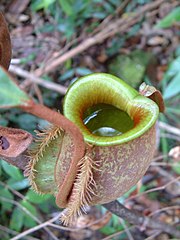
| |||
| Systematyka[1][2] | |||
| Domena | |||
|---|---|---|---|
| Królestwo | |||
| Podkrólestwo | |||
| Nadgromada | |||
| Gromada | |||
| Podgromada | |||
| Nadklasa | |||
| Klasa | |||
| Nadrząd | |||
| Rząd | |||
| Rodzina | |||
| Rodzaj | |||
| Gatunek |
dzbanecznik beczułkowaty | ||
| Nazwa systematyczna | |||
| Nepenthes ampullaria Jack App. Descr. Malay. Pl.: 23 (1821)[3] | |||
| Synonimy | |||
| |||
| Kategoria zagrożenia (CKGZ)[4] | |||
 | |||
Dzbanecznik beczułkowaty (Nepenthes ampullaria) – gatunek rośliny z rodziny dzbanecznikowatych. Występuje w lasach równikowych na wyspach Borneo i Sumatry, w Tajlandii, na Półwyspie Malajskim, w Singapurze i na Nowej Gwinei[3].
Gatunek ten pozyskuje azot głównie z gromadzących się w jego dzbankach opadających szczątków roślinnych[5][6]. W jego dzbankach żyją płazy (Microhyla borneensis) i larwy komarów, którymi żywią się nurkujące i polujące na nie mrówki Camponotus schmitzi[7].
Przypisy
[edytuj | edytuj kod]- ↑ Michael A. Ruggiero i inni, A Higher Level Classification of All Living Organisms, „PLOS One”, 10 (4), 2015, art. nr e0119248, DOI: 10.1371/journal.pone.0119248, PMID: 25923521, PMCID: PMC4418965 [dostęp 2020-02-20] (ang.).
- ↑ Peter F. Stevens, Caryophyllales, [w:] Angiosperm Phylogeny Website, Missouri Botanical Garden, 2001– [dostęp 2009-10-07] (ang.).
- ↑ a b Nepenthes ampullaria Jack. [w:] Plants of the World online [on-line]. Royal Botanic Gardens, Kew. [dostęp 2022-10-02].
- ↑ Nepenthes ampullaria, [w:] The IUCN Red List of Threatened Species (ang.).
- ↑ Maarten J.M. Christenhusz, Michael F. Fay, Mark W. Chase: Plants of the World. Richmond UK, Chicago USA: Kew Publishing, Royal Botanic Gardens, The University of Chicago Press, 2017, s. 438-439. ISBN 978-1-842466346.
- ↑ Charles Clarke, Jan Schlauer, Jonathan Moran, Alastair Robinson: Systematics and evolution of Nepenthes. W: Carnivorous Plants: Physiology, ecology and evolution. Aaron M. Ellison, Lubomir Adamec (red.). Oxford University Press, 2018, s. 58–69.
- ↑ David J. Mabberley, Mabberley’s Plant-Book, Cambridge: Cambridge University Press, 2017, s. 625, DOI: 10.1017/9781316335581, ISBN 978-1-107-11502-6, OCLC 982092200.









